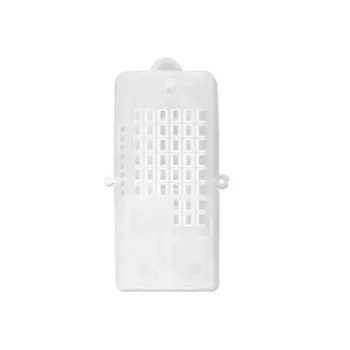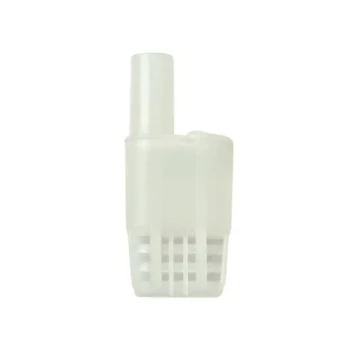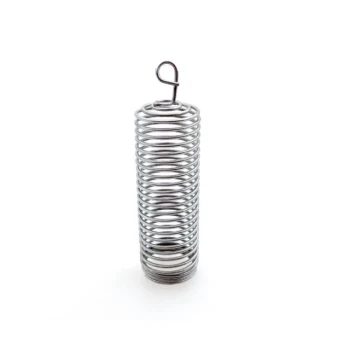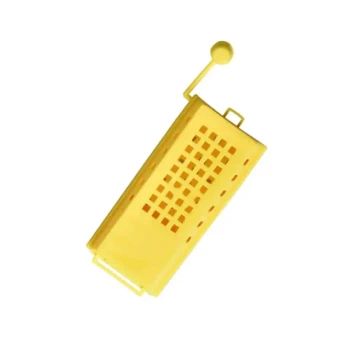At its core, a colony that needs requeening is one where the queen is failing to perform her primary duties, jeopardizing the hive's health, productivity, and long-term survival. The most common signs are a poor brood pattern, a declining population, increased defensiveness, and poor honey production. These symptoms all point back to a single root cause: a compromised queen.
A honey bee colony's performance is a direct reflection of its queen. Recognizing the signs of a failing queen is less about judging her and more about diagnosing the health of the entire superorganism before it enters a state of irreversible decline.
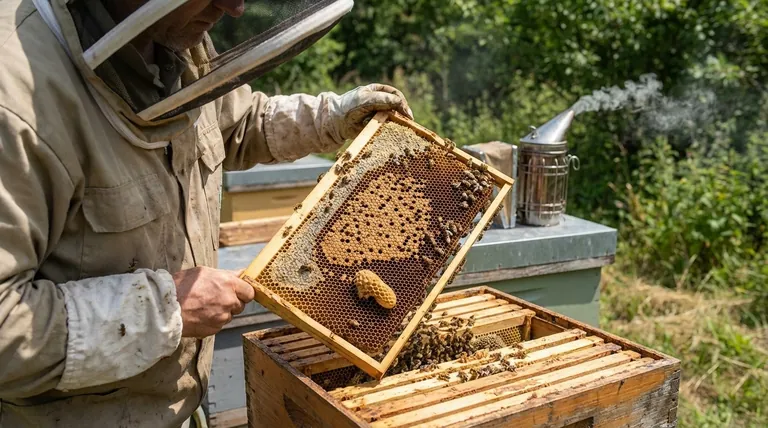
The Queen's Role: The Engine of the Hive
A honey bee queen is the reproductive heart and chemical unifier of the colony. Her two primary responsibilities are laying a prolific number of fertilized eggs and producing pheromones that regulate social cohesion and behavior.
When she excels, the colony thrives. When she falters, the entire system begins to break down. Proactive requeening is one of the most powerful management techniques a beekeeper has to ensure colony success.
Key Indicators of a Failing or Absent Queen
Observing your colony's health is about reading the signs. A struggling hive will present several clear indicators that the queen is the source of the problem.
The Brood Pattern is Unreliable
This is the single most important indicator. A young, well-mated queen lays in a tight, contiguous pattern, often described as a solid wall of brood.
A failing queen will have a spotty or "shotgun" brood pattern, with empty cells scattered among capped brood. You may also see multiple eggs in a single cell or a high proportion of drone brood (larger, dome-capped cells) in worker-sized cells. This indicates she has run out of sperm and can no longer lay fertilized eggs.
The Population is Declining
A direct consequence of a poor brood pattern is a dwindling population. As older bees die off naturally, there are not enough new workers being born to replace them.
An unexplained drop in bee numbers, especially during a nectar flow when the hive should be booming, is a serious red flag.
Honey Production Has Plummeted
Fewer worker bees mean fewer foragers. A colony that consistently underperforms its neighbors in honey production, despite having access to the same resources, often has a queen problem.
This is a lagging indicator; the population decline must become significant before honey stores are noticeably impacted.
The Colony's Temperament Has Changed
The queen's "queen mandibular pheromone" (QMP) is the primary scent that lets every bee know the colony is "queenright" and stable.
If a colony that was once calm suddenly becomes defensive and aggressive, it can be a sign the queen is failing, her pheromone output is low, or she is missing entirely.
The Bees Are Trying to Replace Her
Your bees are often the first to know the queen is failing. They will begin preparations to replace her through a process called supersedure.
Look for one to three large, peanut-shaped "supersedure cells" on the face of a frame. This is a clear sign the bees have initiated their own requeening process. This differs from swarm cells, which are typically more numerous and located along the bottom of frames, indicating a desire to reproduce, not replace.
Understanding the Trade-offs: Intervention vs. Nature
Seeing signs of a failing queen doesn't always mean you must intervene immediately. You have to weigh the risks of action against the risks of inaction.
When to Intervene Immediately
If you see a drone-laying queen (only drone brood present) or confirm the colony is hopelessly queenless (no eggs, no young larvae, and no queen), immediate action is required. The colony cannot recover on its own and will perish without a new queen.
When to Monitor the Situation
If you find a few supersedure cells in an otherwise strong and populous hive, the bees may have the situation under control. Their genetics have prompted them to create a daughter who is adapted to your specific environment.
However, this natural process carries risk. The new virgin queen must emerge, kill her rivals, and successfully complete a dangerous mating flight. Bad weather, predators, or a lack of drones can all lead to failure.
The Risk of Doing Nothing
Allowing a colony to decline too far can be fatal. The population may shrink to a point where it cannot defend itself from pests like wax moths and hive beetles, or survive the winter. Waiting too long removes your option to act.
Making the Right Choice for Your Colony
Your decision to requeen should be based on your specific beekeeping goals and a careful observation of the colony's condition.
- If your primary focus is honey production or pollination: Proactively requeen colonies every 1-2 years with a queen from known, productive genetic stock to ensure peak performance.
- If your primary focus is colony survival and health: Intervene immediately at the first sign of a shotgun brood pattern or a confirmed queenless state to prevent the colony's collapse.
- If your primary focus is natural or treatment-free beekeeping: Allow the bees to attempt supersedure, but monitor them closely and be prepared to introduce a new queen if their efforts fail after a few weeks.
Ultimately, your role as a beekeeper is to be a steward, and knowing when to replace a queen is a critical skill for ensuring your colonies not only survive, but thrive.
Summary Table:
| Key Sign | What to Look For | Why It Matters |
|---|---|---|
| Poor Brood Pattern | Spotty, "shotgun" pattern; multiple eggs per cell; high drone brood. | Indicates the queen is failing to lay properly or is out of sperm. |
| Declining Population | Unexplained drop in bee numbers, especially during a nectar flow. | Fewer new bees are being born to replace older, dying bees. |
| Increased Defensiveness | A once-calm colony becomes aggressive and difficult to inspect. | Suggests the queen's unifying pheromones are weak or absent. |
| Poor Honey Production | Colony underperforms compared to neighbors with similar resources. | A direct result of having fewer worker bees available to forage. |
| Supersedure Cells | 1-3 large, peanut-shaped queen cells on the face of the comb. | The bees themselves are attempting to replace the failing queen. |
Ensure Your Apiary's Success with the Right Equipment
Recognizing the signs of a failing queen is the first step; having the reliable tools and supplies to manage the situation is the next. HONESTBEE is your trusted partner, supplying commercial apiaries and beekeeping equipment distributors with high-quality, wholesale-focused beekeeping supplies.
From durable hive components to essential protective gear, our equipment supports the precise, proactive management required for healthy, productive colonies. Let us help you build a more resilient and profitable operation.
Contact HONESTBEE today to discuss your wholesale supply needs and keep your colonies thriving.
Visual Guide
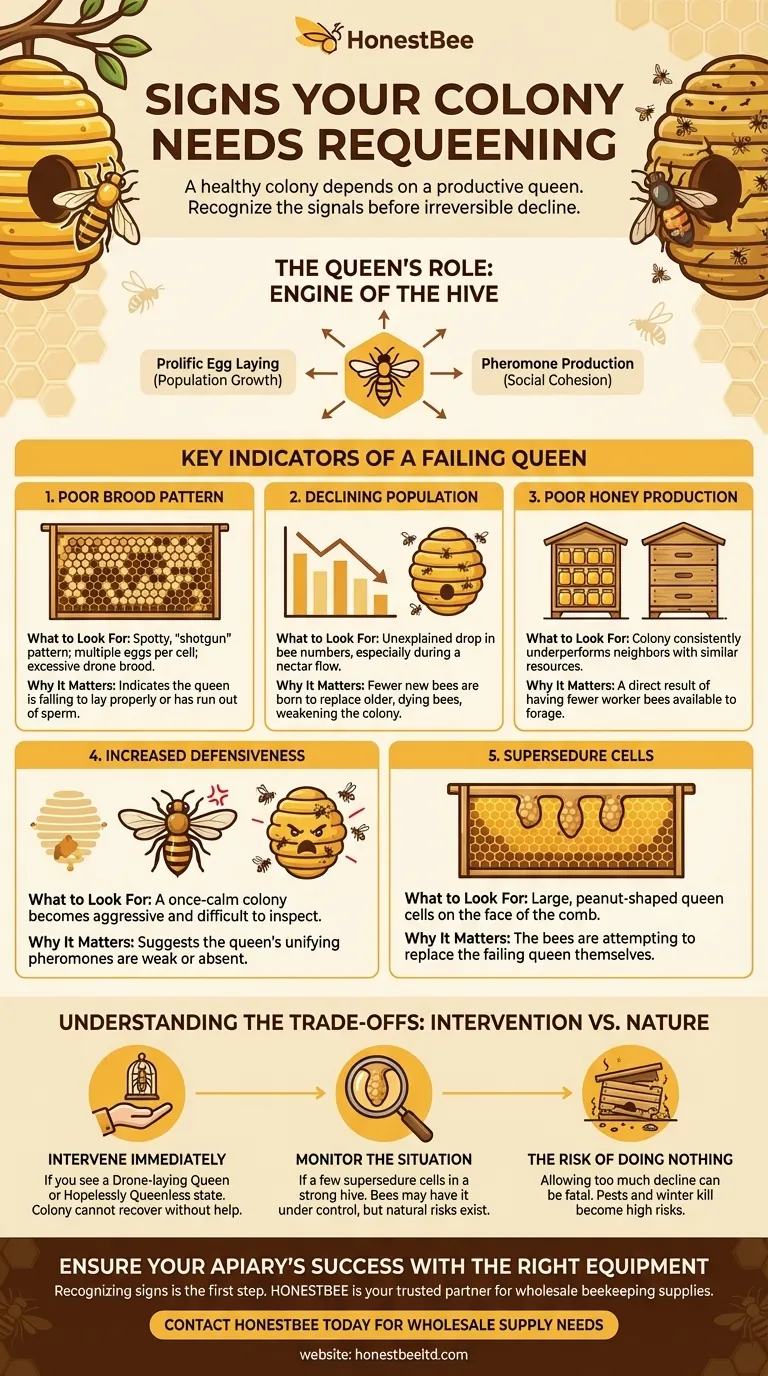
Related Products
- Jenter Queen Rearing Kit Complete Set for Bee Breeding
- No Grafting Queen Rearing Kit: System for Royal Jelly Production and Queen Rearing
- Nicot Queen Rearing Kit for Beekeeping and Grafting in Nicot System
- Professional Multi-Functional Queen Bee Cage
- Multi-Function Queen Roller Cage and Catcher
People Also Ask
- What happens to the colony population during the 5–6 weeks after a new queen emerges? Understand the Natural Dip and Rebound
- What genetic pathways differ in QE-queens? Unlocking the Master Controls of Queen Bee Biology
- What is queen rearing in beekeeping? Take Control of Your Apiary's Genetics
- How can beekeepers start a honey bee breeding program? Build a Superior, Resilient Apiary
- What are the implications of delayed oviposition in queen bees? A Strategy for Superior Queen Quality



